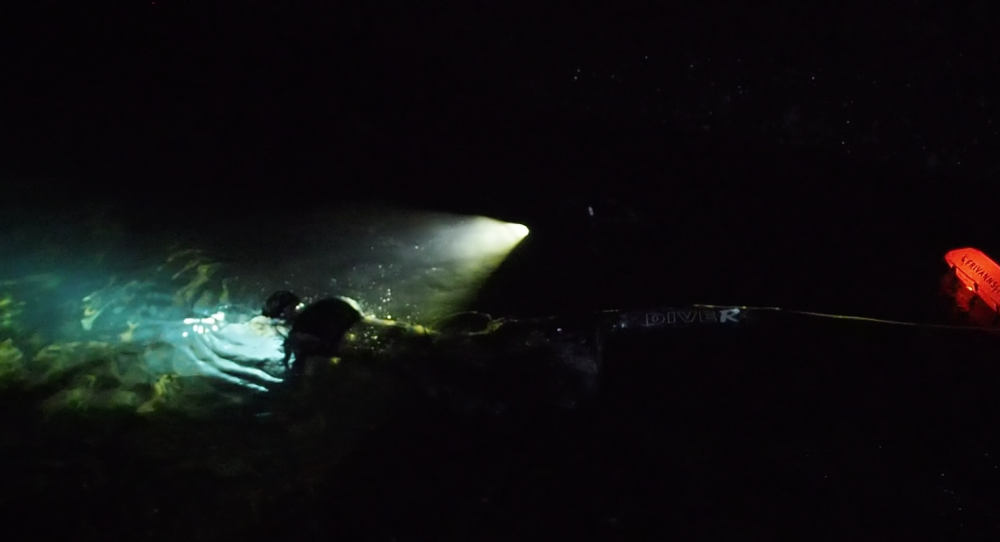Finally we had reached the highlight of Christmas, the obligatory night dive! A wonderful break from food, cakes and more food. The plan was ready. The Elverstraumen between Lindås and Radøy was supposed to explore the onset of darkness. After a couple of phone calls to diving buddy Jan Roald, a good idea came to the surface. What if we park a car far down the stream, then drive back up to the inlet to jump in there? Glorious! Then we can just go with the flow! There are many exciting passages here that you can drive through without thinking about the headwind back home!
By Simen Wilberg and Jan Roald Wolff Treni, 27/12/2018
Alverstraumen is known for being rich in fish and life. Large mountain gilts in particular. The challenge in Alverstraumen is a lot of boat traffic and sometimes poor visibility. Now in winter and at night, however, you can set up safe and good diving trips here.

With full tide at 20.00, it was a perfect match tonight. The cars were parked at Heimetangen. When the current turned, we jumped in and let ourselves drift away! On the trip, we were going to try new equipment. It's always exciting. Jan brought the new OrcaTorch D860, a powerful cannister torch. It was mounted on the harpoon as he wanted to hunt Christmas cod. My plan was to film with the Paralenz camera in combination with the new OrcaTorch D900V video light.

Camera and video light securely mounted on a camera stand.
Before we went into the water, we also placed a simple diving light inside the freediving buoy, which proved to be a very effective way of identifying ourselves in combination with the marker lights we wore on our bodies.

With a lantern inside the buoy, it becomes highly visible in the dark.

A marker light in the mask strap for extra visibility.
Despite some particles in the water, visibility is very good. After only seconds in the water, we see a flounder resting on the sandy bottom. I take a breath and calmly dive down to make some recordings. With a little more lead than normal, I can lie calmly on the bottom without floating back up. This is important to get stable recordings. Anyway, I mostly film in very shallow water during night dives.

Magical atmosphere in the spring stones
We swim further around the first promontory and let the current drift inwards towards Alversund bridge. The mountain walls are wallpapered with starfish in all shapes and colours. A wonderful spectacle! I let myself be enchanted by the colors and life and drift off while Jan looks for fish in slightly deeper water. I count a few crabs. 1-2-3-4-5 pieces in just a few seconds! We must remember this when crabs are on the menu! Then I hear Jan, COD! I swim out to him. A nice cod lies in the kelp forest. Soon it is harpooned. We've only been in the water for a few minutes! We have a chat under a lantern and agree that this was a good idea! Then we swim on for a few minutes before Jan comes swimming again with a great fish, this time a lyre!


Everywhere we approach Kongsøyna and the current picks up sharply. Hey, where's it going! We enter some backwaters and spot several cod drifting away with the current. They are easy to see now as they move across the sandy bottom.
We drift further in behind Kongsøyna. Here it is a quieter current. I see a large gilt resting between the kelp leaves, dive down and film it, and yes, a nice cod appears there! Up to breathe a little and down again!
After over three hours in the water, we are ready to get ashore. The current has taken us to beautiful Solholmen and just inside the car is parked by the old bakery. We take a breather at the water's edge, gut the fish and check the time. Midnight, yes, it is probably time to return home.
About the OrcaTorch D900V and some tips
A wonderful lantern. It is easy to switch between video light and spot light. Search from the surface with spot light and switch to video light when you want to film. Here you get much more out of your trip than only having video light available, which only works to illuminate objects at a short distance. With a magnetic charging cable, it is also easy on the home front.
• If you are going to film, it may be a good idea to use a little extra lead so that you can lie calmly at a depth of 3-5 metres.
• Mark yourself well. A lantern in the buoy is very effective!
• Dive together and close to each other, it is easy to lose sight of each other at night.
• Spend time on the subjects. What you perceive as long jumps when you film may turn out to be short when you see them on the data.
• Get close to the subjects.
• Use strong video light on dark objects such as seaweed and kelp.
• Use weaker video lights on white/bright subjects such as sand and rocks to avoid strong reflections and burnout.
• Use spot lights if you are going to film something from a long distance. 

